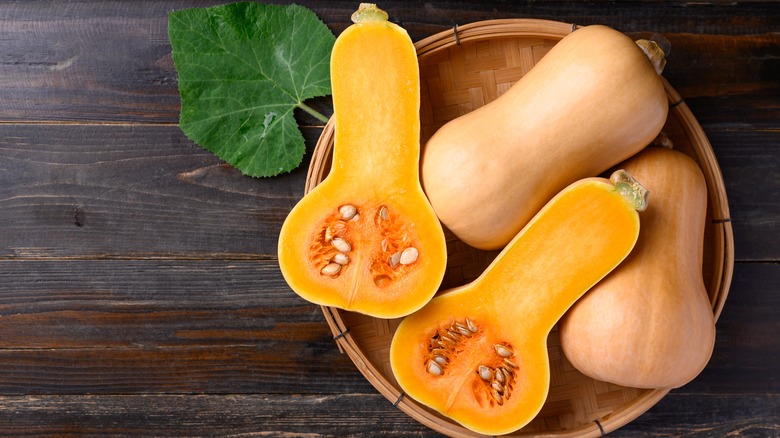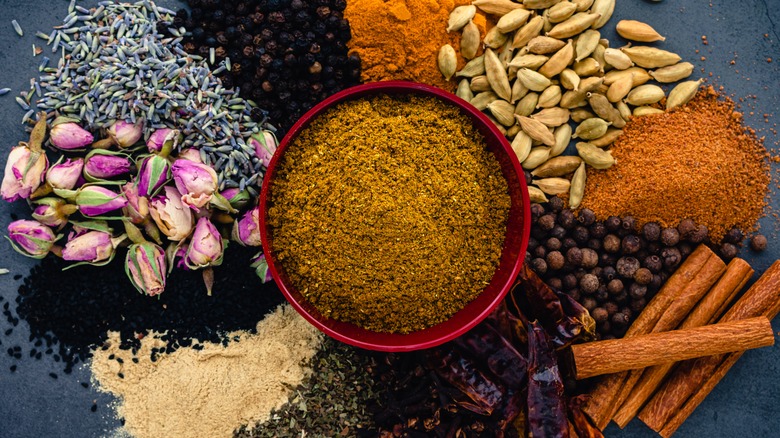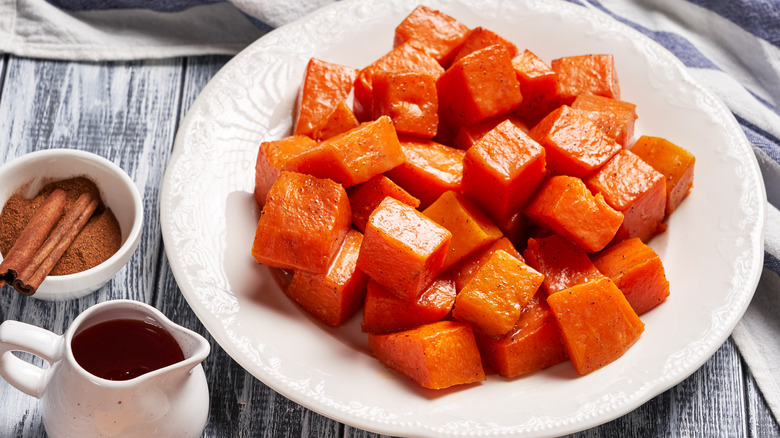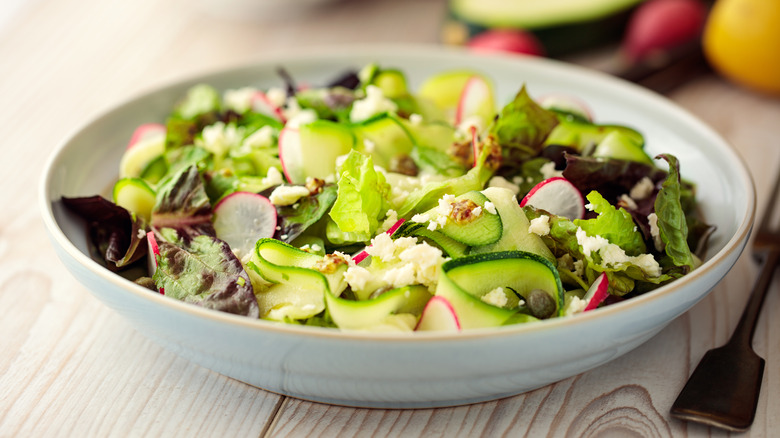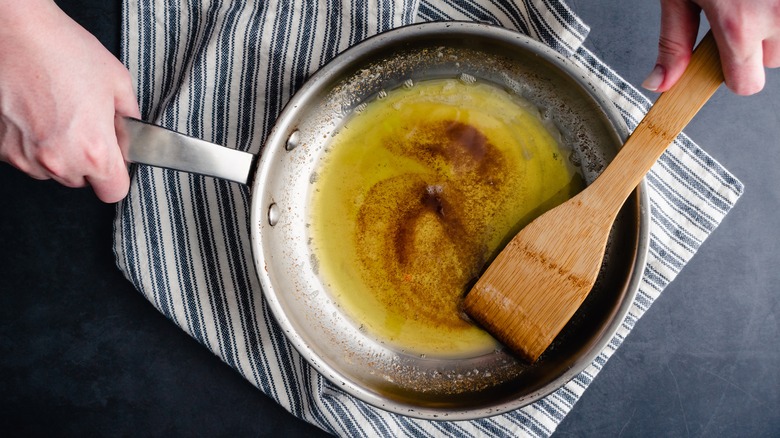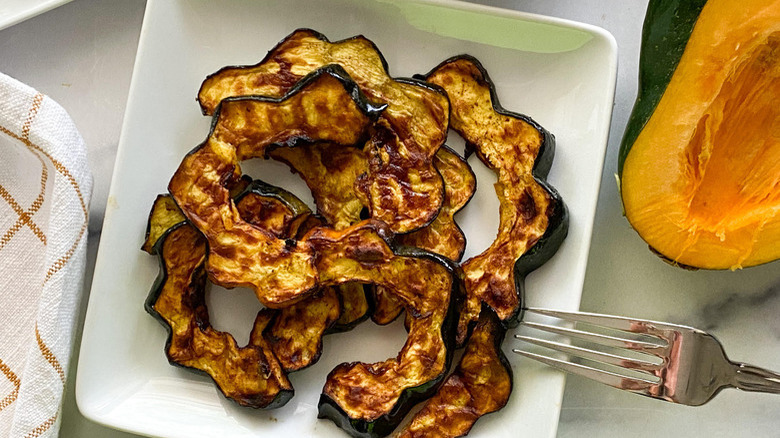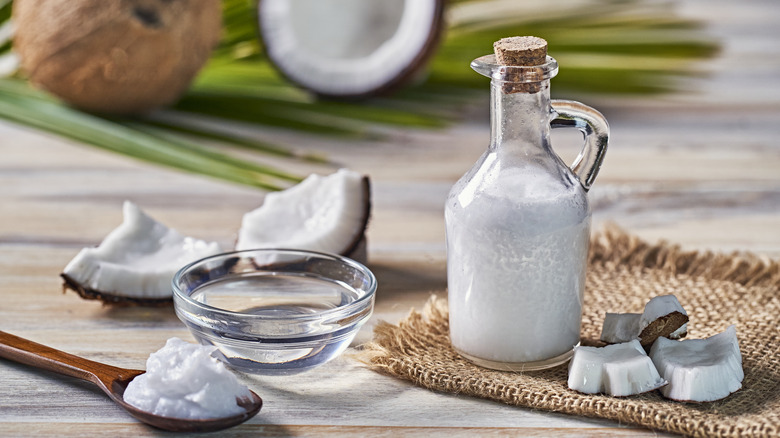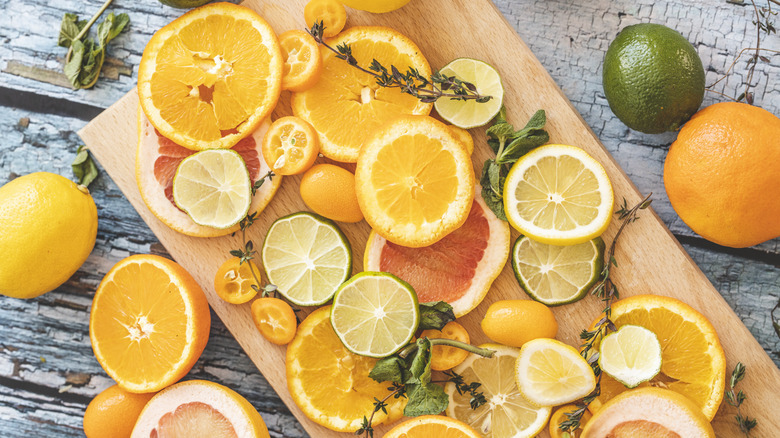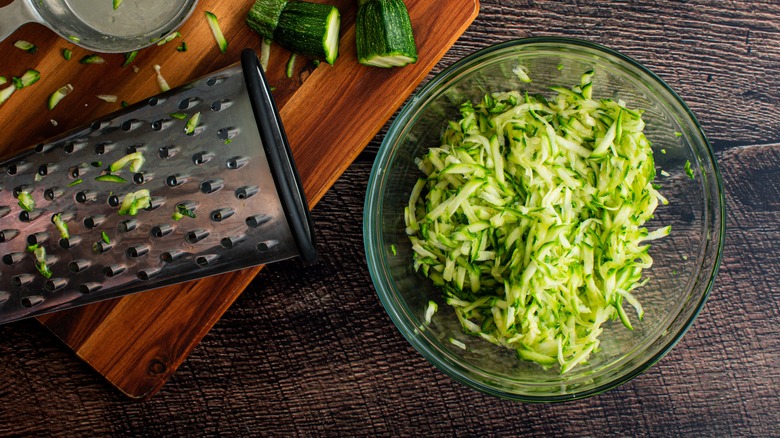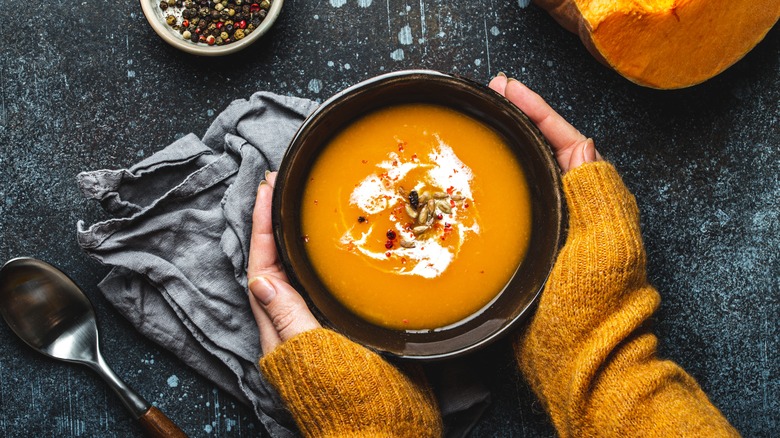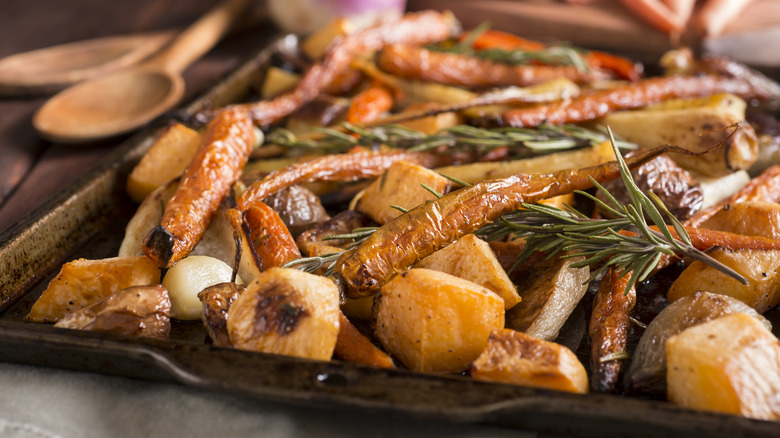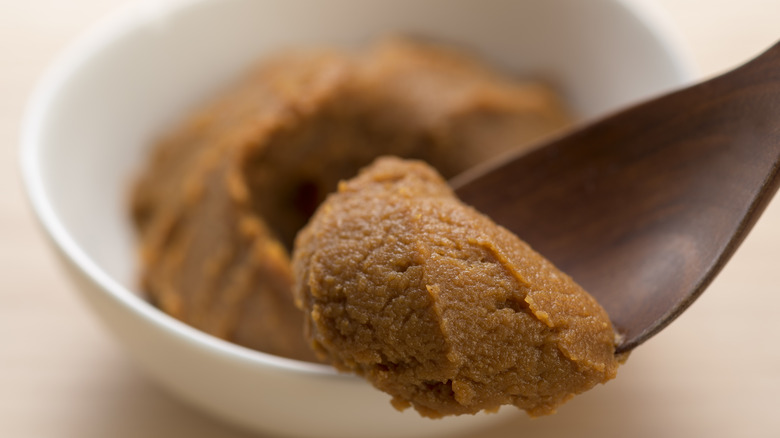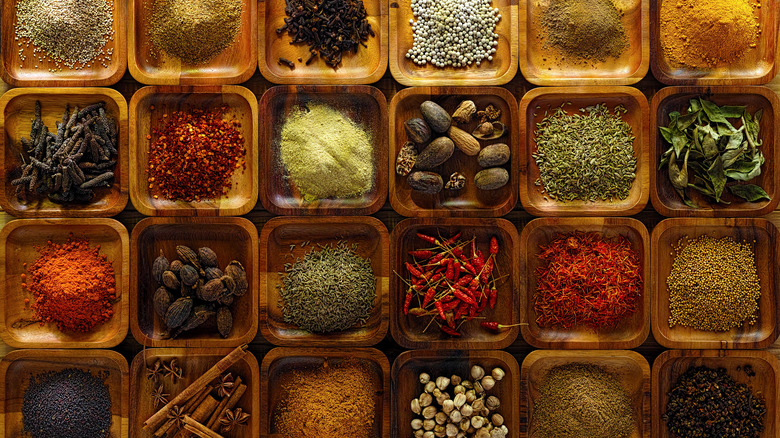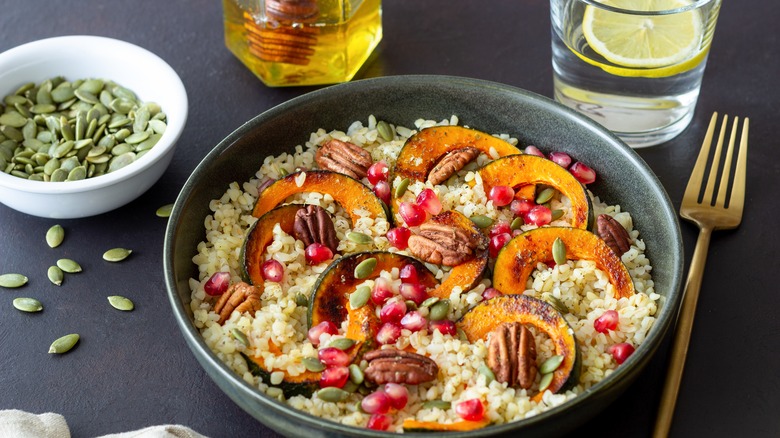14 Simple Ways To Upgrade Squash For More Flavor
Squash is a New World plant that covers a wide range of species. No matter what time of year it is, there's a squash variety ready to improve your meal. In summer, there are glistening zucchinis, pattypan, and yellow squash. In fall and winter, there are butternut, acorn, and spaghetti squash. If you're lucky enough to find a store that carries a wide variety of squash, you might find the green and yellow zephyr, elegantly curved crookneck, deep orange kuri, and sugary honeynut. With a breadth of flavors and textures, squash is full of potential as a side or main dish, no matter the type of meal you're craving.
Sometimes, however, it can be hard to know what to do with squash, especially if you have a variety that you've never cooked with. On the flip side, you might be trying to use up the last bit of squash from your garden after a bumper crop year and feel like you've tried every possible cooking method and flavor combination. Most types of squash taste delicious with nothing more than a little butter, salt, and pepper, but there are many ways to take the flavor up a notch and surprise yourself with something new. With this in mind, we've rounded up some of the easiest ways to add flavor to any variety of squash you get your hands on.
1. Use Moroccan spices
Spice drawers can quickly get out of control, overflowing with a random assortment of ingredients that are difficult to categorize and even more difficult to match harmoniously in a dish unless you're following a recipe. One of the best ways to get the most out of your spice collection aside from freestyling and hoping for the best is to follow the lead of various cuisines. In Morocco, for example, many dishes include a combination of several spices that have been honed over the years to be balanced, fragrant, and utterly mouthwatering. When added to something simple like roasted squash, a Moroccan spice blend will bring the dish to life.
Some brands sell their own Moroccan spice blends, but you can easily make one at home. This has the additional benefit of allowing you to highlight the character you favor. One of the most famous blends is called ras el hanout, an Arabic phrase roughly translated to "top shelf." In other words, it's the first blend you'll want to reach for when you start cooking. To make it, you'll need to combine sweet and warm spices like nutmeg, cardamom, cinnamon, ginger, and cloves, with earthier spices like coriander, turmeric, and cumin. Cayenne can be thrown in for an extra kick, while allspice can enhance the warming spices.
2. Use maple syrup or brown sugar
Winter squash has an underlying sweetness that makes it a natural fit for dessert recipes like pies, cakes, and muffins. Even when you're making them a dinner side dish, a little added sugar creates a delicious variation to an otherwise savory meal and brings out the natural nutty sweetness of the squash.
One easy way to make a sweetened squash recipe even more delicious is to simply substitute brown sugar or maple syrup in place of white sugar. Since the sweetness in squash is characterized by an earthy flavor, brown sugar provides a complementary deep nuttiness. Maple syrup provides a similar function, but adds to it with a quintessential autumn flavor. Make this simple maple-roasted delicata squash recipe or a simple roasted butternut squash recipe and you'll be transported to the time of falling leaves, pumpkin spice, and oversized sweaters. The best part is that these recipes are largely hands-off and only take a few minutes of preparation. For the amount of effort you have to put into them, they are punching far above their weight in terms of flavor.
3. Serve it raw
By far the easiest way to upgrade squash is, paradoxically, to do nothing at all. That's right: summer squash can be eaten raw. The best way to tell whether a type of squash is a summer or a winter is to check the skin. If it's a summer squash, like zucchini or pattypan squash, the skin will be thin enough to eat. If it's a winter squash (the kind you don't want to eat raw), its skin be thick and chewy, the kind you'd peel before cooking. Without cooking, winter squash is tough, with a subtly bitter flavor from the toxin Cucurbitacin E. Summer squash, on the other hand, are tender when they're raw and have a fresh flavor.
The best way to eat uncooked summer squash is to put it in salads or use it for dipping into hummus. In fact, treating it exactly as you would treat cucumber is the best way to go. You might not want to eat them on their own like a carrot, but with a little tzatziki or balsamic vinaigrette, they provide a pleasantly tender texture and mild flavor. When grated onto salads, they also provide another layer of bright color. Eating uncooked summer squash is so rare and delicious that it has to qualify as an upgrade even though it requires the least possible effort of any preparation.
4. Use brown butter instead of regular butter
Brown butter is the secret to many a stellar recipe. Want to make extra caramelly chocolate chip cookies? Brown the butter. Want to turn a simple pasta dish into something spectacular? Swap the regular butter for browned butter. Want to bring out the richness and nuttiness in a butternut squash? You guessed it –- use brown butter. If you've never made it before, brown butter might be intimidating. However, as long as you keep a watchful eye on the skillet, you don't have to worry about ending up with a pan of charred, smoking oil.
There are a few ways to increase the likelihood that your recipe will turn out well. For starters, you should always use a stainless steel pan to brown butter because the light color of the metal makes the darkening shade of the butter much easier to see compared to non-stick or cast iron skillets. You should also try to use a pan with a heavy bottom since thickness helps retain and distribute the heat more evenly.
There are many ways to incorporate brown butter into your squash recipes. You can add it to a butternut squash purée or drizzle it over roasted acorn squash. You can even take an extra step and make a dressing with it. The good news is that once browned butter is involved, it's hard to go wrong.
5. Add warming spices
Winter squash is nutty and sweet, especially when it's roasted. When adding flavor, you could opt for something completely different to create contrast, but squash has an inherently subtle taste that is more suited to ingredients that enhance it rather than those that add complexity. For this reason, sweet, warming spices are one of the best options. They bring out the natural sugar of squash while adding a hint of spiciness that will excite your taste buds without overwhelming them.
The options are wide-ranging. Our air fryer roasted acorn squash recipe, for example, calls for nothing but cinnamon, but you can deepen the sweet, autumnal profile of the dish by adding cloves, ginger, and allspice. If you don't want the squash to be too sweet, you can liven things up with heat rather than warmth. A simple dash of cayenne can change the whole character of the recipe, while chili powder or chili flakes add a savory edge.
6. Use unrefined coconut oil
One of the best ways to upgrade squash is to swap out the prescribed type of oil with a more flavorful variety. Many recipes call for neutrally flavored cooking oils such as canola or sunflower seed oil, but if you want to boost flavor with little effort, opt for unrefined coconut oil instead. The result will be rich and nutty without the need to alter the recipe.
Coconut oil has enjoyed a spate of intense popularity in recent years and is therefore widely available. But when you buy it to upgrade squash, check the labels carefully. If you've ever hoped to add a coconut-y flavor to a recipe with coconut oil, only to discover that the product you purchased is tasteless and fragrance-free, you were likely using a refined version. The difference between unrefined and refined coconut oil has more to do with processing methods than nutritional benefits. Unrefined coconut oil (also called "virgin" or "pure" coconut oil) is extracted from the meat of the coconut and is full of coconut flavor and scent. Refined coconut oil, on the other hand, undergoes a process to remove the gum and neutralize the fatty acids. It is also bleached and deodorized to get rid of any traces of coconut flavor or smell.
7. Bread and fry it
Despite its many vitamins and nutrients, squash is just as capable of becoming a greasy, mouthwatering comfort food as any potato. Our recipe for Southern-style fried squash leads to perfectly crunchy, salty results that are nutritionist-approved (it was created by health coach, Miriam Hahn). Whether you're making it as an appetizer, a side dish, or an afternoon snack, this recipe is bound to hit the spot.
To produce just the right amount of crunchiness, the recipe calls for a combination of cornmeal and panko breadcrumbs, which Hahn explains provide different textures. You'll also need eggs, milk, and, of course, squash (our recipe calls for yellow summer squash). To ensure that each slice is coated in breading, dip the squash in the milky egg mixture and dredge it in the breadcrumbs and cornmeal several times. The more breading they have, the crunchier they will be. Serve the fried squash with your favorite dipping sauces. Hahn suggests ranch dressing, blue cheese dressing, buffalo sauce, and garlic aioli sauce. They also taste delicious on their own.
8. Add citrus
Whether you're making a dessert or a savory main dish, citrus is almost always a good idea. Chocolate with orange zest, chicken with lemon juice, and raw fish with lime zest are just a few examples of how transformative this category of fruit can be, and squash is not immune from its powers. For summer squash, the bright, tangy flavors of lemon and lime work best, drawing out the freshness of the warm-weather veggie. Grate some lime zest over grilled yellow squash or add a squeeze of lemon to zucchini sautéed with garlic for the perfect summer dish.
If you're making winter squash, sweeter citrus fruit highlights its natural sugar. A butternut squash purée tastes even more delicious with orange juice than it does with milk, while orange zest can add a whole new dimension to roasted winter squash. You can even turn the fruit into a sweet and tart glaze by mixing maple syrup with orange zest or allowing sugar to dissolve into the juice.
9. Caramelize it
If you've never heard of caramelized zucchini, you're about to meet your new favorite summer recipe. The process is similar to caramelizing onions. Slice the zucchini lengthwise into thick ribbons, add them to a skillet with butter and salt, and cook them on low for about 20 minutes until they have reduced to a fraction of their original size and turned translucent. All of a sudden, the subtle flavor of sautéed zucchini is replaced with an intense sweetness akin to caramelized onions. Add them to summer tarts, sandwiches, and scrambled eggs.
Another option is to grate the zucchini first, resulting in something more akin to sauce or paste than veggies. If you let it caramelize for as long as 30 to 45 minutes, it will be an unrecognizable greenish-brown substance that may not look particularly appetizing, but will taste divine when used as a replacement for pesto.
Caramelizing zucchini is a particularly useful option when you purchase too much or have a garden during peak season. Just like greens or onions, zucchini cooks down to almost nothing, allowing you to get rid of a large quantity all at once.
10. Add fat
It's no revelation that fat makes most food taste better. Whether you're toasting bread or cooking carrots, a dash of butter, cream, or cheese will almost certainly make the outcome more delicious. Like many veggies, squash is crying out for fatty ingredients. Not only does adding fat help prevent it from sticking to the pan if you're roasting or sautéing, but it also creates a rich, flavorful taste that squash just doesn't have on its own. If you're trying to use up the squash you have in your fridge but don't have many ingredients on hand to add flavor, look for whatever fat-based food you have lying around. Butter and oil are the obvious choices, but cheese can work wonders as well. Goat cheese, with its sharpness and creaminess, is a perfect ingredient to balance the mild sweetness of winter squash, while cheddar and Parmesan will add a salty umami flavor and taste even more delicious when browned and slightly crunchy.
Don't overlook liquid ingredients either. Milk, cream, coconut milk, and sour cream can work wonders on squash, whether you're blending them into a purée, like in our savory mashed butternut squash recipe, using them as a broth to boil the squash, or adding them to the soup.
11. Combine it with root vegetables
Even though squash is not a root vegetable, there's a reason so many recipes call for winter squash to be paired with potatoes, carrots, parsnips, and other veggies that grow underground. The nutty sweetness of winter squash varieties like butternut and acorn squash blends perfectly with the sweet earthiness of root vegetables and tubers like carrots and sweet potatoes. They share a dense, starchy texture, and you might even find it difficult to tell sweet potatoes and delicata squash apart once they're peeled and cooked.
When you want to make a recipe with root vegetables and winter squash, there is no shortage of options. You could stick to the classic, no-fail option of roasting them, incorporate them into another recipe like a stir-fry or quiche, or turn them into soup. Our roasted root vegetable soup, for example, is made with butternut squash, sweet potatoes, and parsnips, resulting in a creamy, earthy dish that is perfect for autumn and winter meals.
Another option is to simply add root vegetables to a recipe that calls for only squash. If you have a type of squash that tastes a bit bland on its own, replace a portion of the prescribed quantity with sweet potatoes to add sweetness and variety.
12. Add miso paste
Having a jar of miso in the fridge is always a good idea. It will come in handy more often than you can imagine and will take your cooking to the next level. Whether you're making salad dressing, creamy pumpkin soup, or chocolate chip cookies, the fermented soybean paste will transform the recipe with its potent umami flavor. In this light, adding it to squash is a no-brainer. If you're grilling zucchini in the summertime, whip up a miso dressing with soy sauce and a little sugar, and marvel at the results.
With winter squash, the results are even more stunning. Miso provides an earthy, savory flavor, but most recipes combine it with sugar to provide a mouthwatering contrast. Winter squash has sweetness and earthiness, and when combined with sweet and savory miso dressing, it becomes an intensely flavor dish that is perfectly balanced. Keep in mind that with miso, a little goes a long way and less is better than too much. Our creamy pumpkin soup recipe, for example, yields five servings and calls for only one tablespoon of miso.
13. Add curry spices
For a speedy upgrade to squash that doesn't require you to adjust the recipe yet completely transforms the dish, then look no further than your favorite spice blend. Curry is associated with such a specific flavor that, even though it's just a generic word for sauce, many people think of it as a blend of spices. There are even spice blends labeled as curry. Buying so-called curry powder and adding it to your recipe will yield delicious results, but you can also make your own blend. Garam masala is one of the most popular types of curry spice mixes and is easily replicable by combining cardamom, cinnamon, coriander, cumin, cloves, black pepper, and nutmeg.
When adding it to squash, you can make things as simple as tossing the chopped veggies in the spice mix along with oil before roasting, or go all-in and make a curry. Our Instant Pot butternut squash curry recipe makes things easy, taking only 15 minutes to prepare and 15 minutes to cook.
14. Add nuts and seeds
Garnishes are some of the most gratifying cooking hacks. They tend to require little preparation and instantly make a dish look classier, whether you're adding a few sprigs of mint to a bowl of vanilla ice cream or sprinkling parsley over a bowl of chili. Although few recipes call for it, winter squash benefits greatly from garnishes due to its simplicity and mild flavor. Although herbs are a good option, nuts are even better. Winter squash tends to have a nutty flavor already (as is evident in the naming of butternut and honeynut squash), and adding some toasted nuts and seeds elevates the flavor.
When it comes to choosing which type of nuts and seeds to use, you don't need to worry about procuring the perfect option. Each variety will add its own appeal, and almost all will taste delicious. Pumpkin seeds and pistachios provide an earthy green color, walnuts and pecans add buttery flavor, and pine nuts add richness. Aside from peanuts, which have a strong flavor that can dominate even the most powerful dishes, whatever nuts and seeds you have sitting in your pantry will almost certainly give you delicious results.
